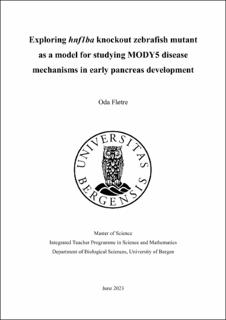| dc.description.abstract | Maturity-onset diabetes of the young (MODY) is a monogenic form of diabetes, characterised by pancreatic beta-cell dysfunction, early onset (before around 25 years of age), and autosomal dominant inheritance. Heterozygous mutations in the hepatocyte nuclear factor-1 beta (HNF1B) gene are found to cause MODY5, a severe subtype of MODY. This subtype is associated with a wide range of clinical manifestations, including pancreas hypoplasia, renal abnormalities and genital malformations. Currently, there is no fully representative animal model for studying MODY5 disease development in the pancreas. To address this issue, we investigated a homozygous hnf1ba knockout zebrafish model, representing the L16fs mutation found in humans. Our study demonstrates the essential role of hnf1ba in pancreas development. The knockout of hnf1ba leads to significant alterations in the expression levels of several genes associated with pancreas development and function. We observed increased expression levels of foxa3, gcga, hnf1bb, insb and pax6b, and decreased levels of gcgb, insa and pdx1. By immunostaining glucagon- and insulin-producing cells, we identified structural variations in the pancreas among hnf1ba(-/-) zebrafish larvae. The mutants exhibited a lower average number of alpha- and beta-cells compared to wild-type larvae; however, this reduction was not statistically significant. These observed variations suggest variable penetrance of the hnf1ba mutation, consistent with previous findings of varying phenotypes in MODY5 patients. Moreover, we observed various morphological abnormalities in the mutants, including a curved tail, enlarged yolk sac, pericardial edema and reduced heart rate, indicating a multisystemic nature similar to MODY5. We anticipate our study as a starting point towards establishing a new in vivo model of MODY5 disease. The model has the potential to provide deeper insights into the role of hnf1ba and hence advance our knowledge of its relevance to human health and MODY5 pathogenesis. | |
